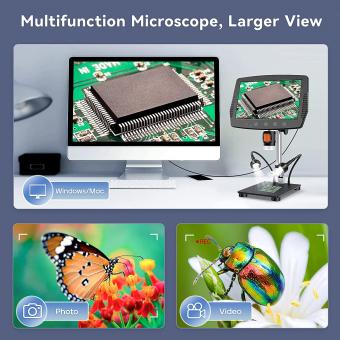Microscope That Can See Germs ?
A microscope that can see germs is typically referred to as a compound microscope. Compound microscopes use multiple lenses to magnify the image of the specimen, allowing for the visualization of microscopic organisms such as bacteria and viruses. These microscopes have a higher magnification power compared to simple microscopes, enabling scientists and researchers to study the structure and behavior of germs in detail. Additionally, some compound microscopes are equipped with advanced features like phase contrast or fluorescence microscopy, which enhance the visibility of germs by highlighting specific characteristics or using specific dyes. Overall, compound microscopes play a crucial role in microbiology and medical research, enabling scientists to observe and understand the world of germs at a microscopic level.
1、 Optical Microscopy: Visualizing Germs with Light-Based Microscopes
Optical Microscopy: Visualizing Germs with Light-Based Microscopes
Optical microscopy has long been a valuable tool in the field of microbiology, allowing scientists to visualize and study microorganisms, including germs, with great detail. These microscopes use visible light to illuminate the specimen and magnify it, enabling researchers to observe the structure, behavior, and interactions of germs.
One of the key advantages of optical microscopy is its ability to provide real-time imaging of live germs. By using specialized staining techniques, scientists can enhance the contrast of the specimen, making it easier to distinguish different types of germs and their various components. This allows for the identification and characterization of specific pathogens, aiding in the diagnosis and treatment of infectious diseases.
In recent years, advancements in optical microscopy have further improved our ability to study germs. For instance, confocal microscopy has revolutionized the field by providing high-resolution, three-dimensional images of germs. This technique uses a laser to scan the specimen layer by layer, resulting in sharp images with excellent depth perception. It has proven particularly useful in studying the complex structures and interactions of biofilms, which are communities of microorganisms that adhere to surfaces.
Furthermore, the development of super-resolution microscopy techniques, such as stimulated emission depletion (STED) microscopy and structured illumination microscopy (SIM), has pushed the boundaries of optical microscopy. These techniques surpass the diffraction limit of light, allowing for the visualization of even smaller structures within germs. This has opened up new avenues for studying the nanoscale organization of proteins, membranes, and other cellular components, providing valuable insights into the mechanisms of germ pathogenesis.
In conclusion, optical microscopy continues to be an invaluable tool for visualizing germs and studying their behavior. With advancements in staining techniques and the development of super-resolution microscopy, scientists can now observe germs with unprecedented detail, shedding light on their complex biology and aiding in the development of novel therapeutic strategies.

2、 Electron Microscopy: Revealing Germs at the Nanoscale Level
Electron Microscopy: Revealing Germs at the Nanoscale Level
The field of electron microscopy has revolutionized our understanding of germs by allowing us to observe them at the nanoscale level. This powerful tool has provided scientists with unprecedented insights into the structure, behavior, and interactions of various microorganisms.
An electron microscope is a type of microscope that uses a beam of electrons instead of light to magnify the specimen. This enables researchers to achieve much higher resolution and greater detail compared to traditional light microscopes. By using electron microscopy, scientists have been able to visualize germs with incredible precision, revealing their intricate features and mechanisms.
One of the most significant advantages of electron microscopy is its ability to capture images of germs that are too small to be seen by the naked eye or even by conventional light microscopes. This has allowed researchers to study the ultrastructure of bacteria, viruses, and other pathogens, providing crucial information about their morphology, surface characteristics, and internal organization.
Moreover, electron microscopy has played a vital role in advancing our understanding of the interactions between germs and their host organisms. By visualizing the attachment of pathogens to host cells or tissues, scientists have gained insights into the mechanisms of infection and the development of diseases. This knowledge has been instrumental in the development of new treatments and preventive measures.
In recent years, electron microscopy techniques have continued to evolve, enabling even more detailed and comprehensive studies of germs. Advanced imaging methods, such as cryo-electron microscopy, have allowed scientists to observe germs in their native state, providing a more accurate representation of their structure and behavior.
In conclusion, electron microscopy has been a game-changer in the study of germs. By revealing their intricate details at the nanoscale level, this powerful tool has deepened our understanding of microorganisms and their interactions with the environment and host organisms. As electron microscopy techniques continue to advance, we can expect further breakthroughs in our knowledge of germs and their impact on human health.

3、 Fluorescence Microscopy: Enhancing Germ Detection with Fluorescent Labels
Fluorescence Microscopy: Enhancing Germ Detection with Fluorescent Labels
Fluorescence microscopy is a powerful tool that has revolutionized the field of germ detection. By using fluorescent labels, scientists can enhance the visibility of germs and gain valuable insights into their behavior and characteristics. This technique has proven to be particularly effective in identifying and studying pathogens that are otherwise difficult to detect using conventional microscopy.
One of the key advantages of fluorescence microscopy is its ability to specifically target and visualize germs. By attaching fluorescent labels to specific molecules or structures within the germs, researchers can easily distinguish them from the surrounding background. This allows for precise identification and tracking of germs, even in complex samples such as biological tissues or environmental samples.
Moreover, fluorescence microscopy enables real-time imaging of germs, providing dynamic information about their movement, interactions, and response to various stimuli. This has greatly contributed to our understanding of germ behavior and pathogenesis. For example, researchers have used fluorescence microscopy to study the mechanisms of bacterial infection, viral replication, and the spread of antibiotic resistance.
In recent years, advancements in fluorescence microscopy have further enhanced its capabilities in germ detection. Super-resolution microscopy techniques, such as stimulated emission depletion (STED) microscopy and structured illumination microscopy (SIM), have pushed the limits of resolution, allowing for the visualization of even smaller germs and subcellular structures. Additionally, the development of genetically encoded fluorescent proteins has enabled the labeling of specific germs or cellular components with high specificity and brightness.
Overall, fluorescence microscopy has become an indispensable tool in the field of germ detection. Its ability to enhance visibility, provide real-time imaging, and offer high-resolution imaging has greatly advanced our understanding of germs and their impact on human health. As technology continues to evolve, fluorescence microscopy will undoubtedly play a crucial role in future research and the development of new strategies to combat infectious diseases.

4、 Scanning Probe Microscopy: Examining Germs through Surface Interactions
Scanning Probe Microscopy: Examining Germs through Surface Interactions
Scanning Probe Microscopy (SPM) is a powerful tool that allows scientists to examine germs at the nanoscale level. This technique involves using a tiny probe to scan the surface of a sample, measuring various properties such as topography, conductivity, and magnetic fields. By analyzing the interactions between the probe and the sample, SPM provides valuable insights into the structure and behavior of germs.
One of the most commonly used types of SPM is Atomic Force Microscopy (AFM). AFM works by scanning a sharp probe over the surface of a sample, measuring the forces between the probe and the sample. This allows researchers to create high-resolution images of germs, revealing their shape, size, and surface features. AFM can also be used to study the mechanical properties of germs, such as their stiffness and elasticity.
Another type of SPM, Scanning Tunneling Microscopy (STM), can be used to examine the electronic properties of germs. STM works by scanning a conductive probe very close to the surface of a sample, allowing electrons to tunnel between the probe and the sample. By measuring the current flowing between the probe and the sample, researchers can map out the electronic structure of germs, providing insights into their chemical composition and reactivity.
The latest advancements in SPM technology have further enhanced our ability to study germs. For example, researchers have developed new types of probes with improved sensitivity and resolution, allowing for even more detailed imaging of germs. Additionally, the integration of SPM with other techniques, such as fluorescence microscopy, has enabled simultaneous imaging of both the surface and internal structures of germs.
In conclusion, Scanning Probe Microscopy, including techniques like AFM and STM, provides a powerful means to examine germs at the nanoscale level. By analyzing surface interactions, SPM allows researchers to gain valuable insights into the structure, properties, and behavior of germs. The latest advancements in SPM technology continue to push the boundaries of our understanding of germs and pave the way for new discoveries in microbiology and medicine.







































